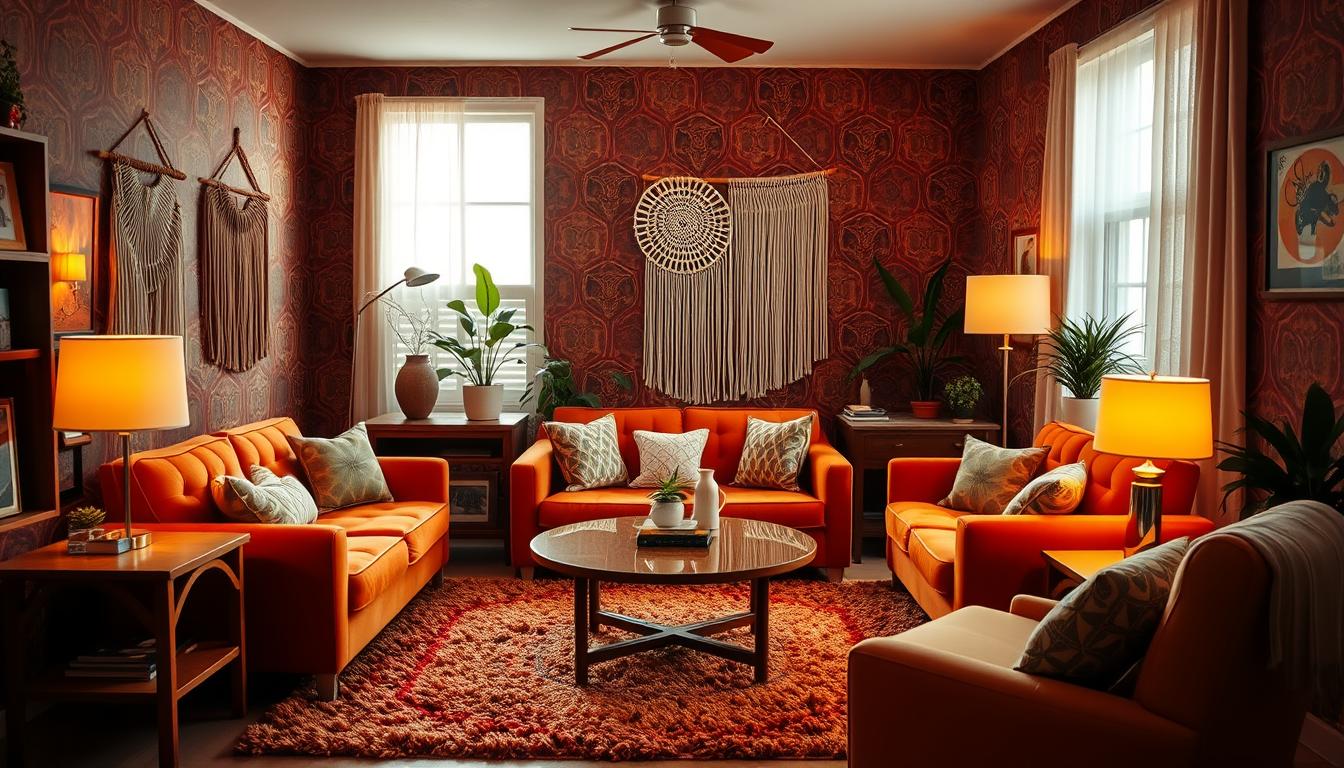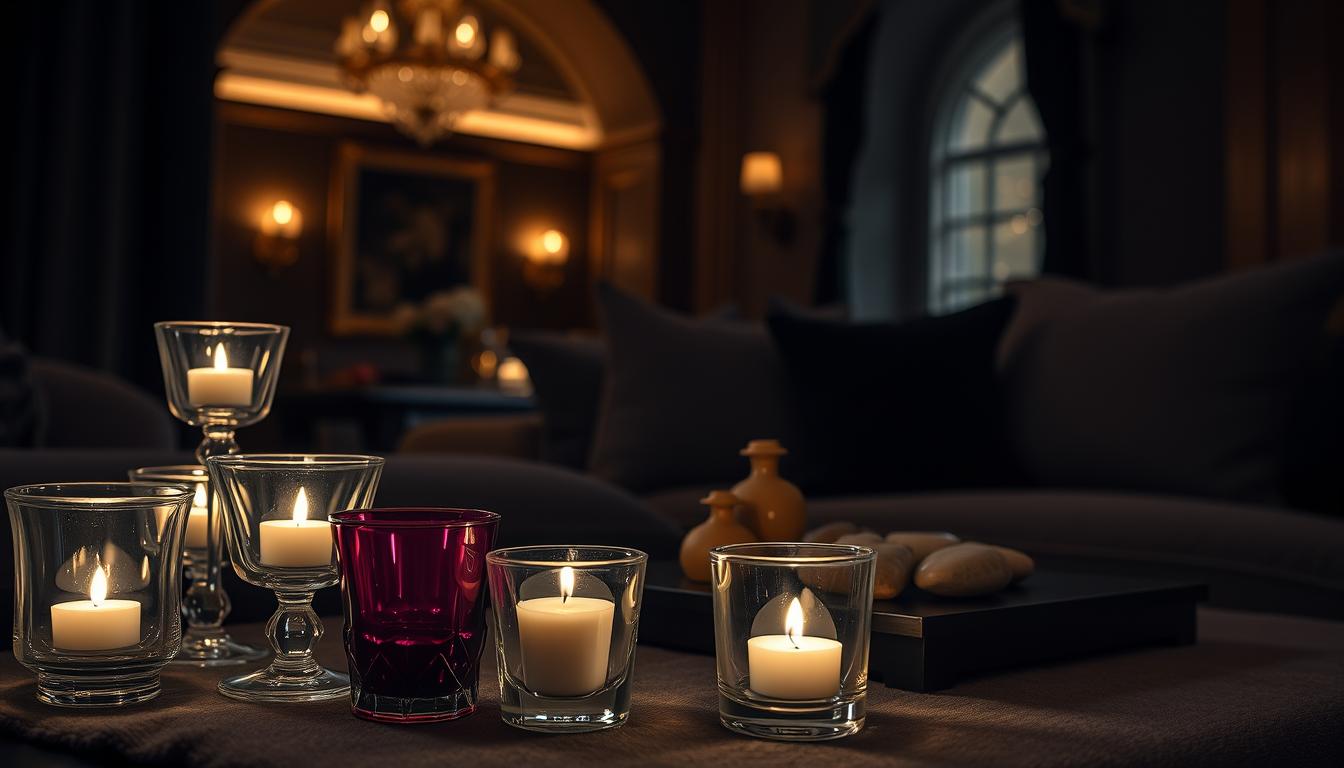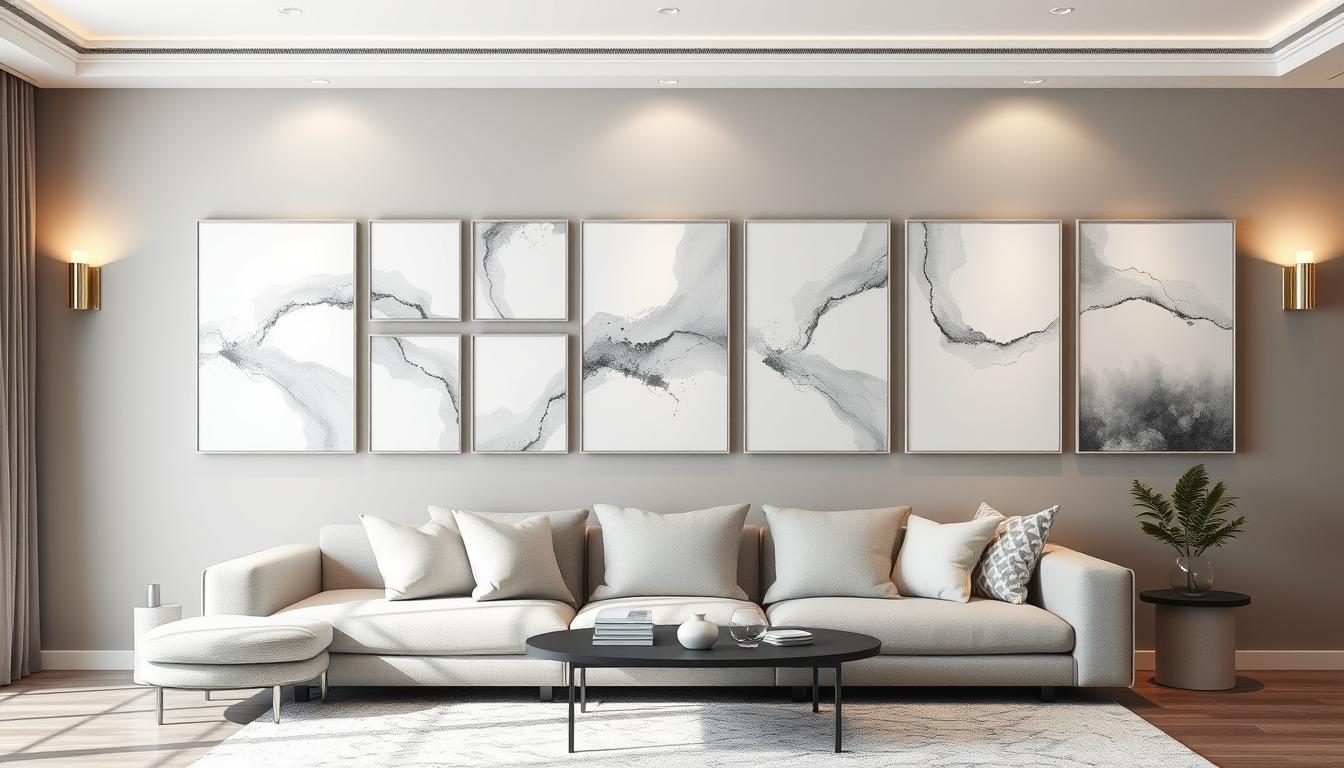The 1970s brought big changes in retro interior design. We saw bold colors, funky patterns, and unique styles. This decade changed how people decorated their homes, making it a fun topic to explore.
As we look into 1970s decor, we’ll see how these old trends still shape today’s interior design. We’ll see how vintage patterns and bold colors are back. The 1970s made a lasting impact on design.
Key Takeaways
- Understanding the significance of 1970s design trends
- Exploring the influence of retro interior design on contemporary styles
- Identifying key elements that define 1970s decor
- Learning how to incorporate vintage trends into modern design
- Discovering the cultural context that shaped 1970s interior design
A Brief Overview of 1970s Interior Design Trends
The 1970s was a decade of big changes in interior design. It showed the era’s cultural and social shifts. People started to show their unique style through their homes.
Key Characteristics of 1970s Design
The 1970s design was all about bold colors and funky patterns. People used bright colors and unique decor to make their homes stand out. Some key features include:
- Bold, bright colors on walls and furniture
- Eccentric patterns, such as paisley and florals
- Use of natural materials and textures
- Eclectic decor, including vintage and antique pieces
These elements made homes in the 1970s truly unique. The bold colors and patterns added fun. Natural materials brought warmth and coziness.
Major Influences on the Aesthetic
Many things influenced 1970s design, like cultural and social changes. Pop culture, including music and movies, was a big influence. For example, disco culture led to flashy decor, while the counterculture movement favored natural elements.
| Influence | Impact on Design |
|---|---|
| Pop Culture | Glamorous, flashy decor; bold colors |
| Counterculture Movement | Natural, earthy elements; eclectic decor |
| Technological Advancements | New materials and textures; futuristic designs |
The Role of Pop Culture
Pop culture greatly shaped 1970s design. Icons like Farrah Fawcett and Studio 54 inspired bold decor. The era’s music and movies also influenced design, with people adding elements that showed their style and cultural ties.
For instance, disco music led to flashy lighting and decor. Hollywood films inspired the use of luxurious materials and opulent furnishings.
Colors that Define the Decade
In the 1970s, homes were filled with earthy tones and bright colors. This decade loved colors that made spaces warm and lively.
Earthy Tones and Vibrant Accents
Avocado green and harvest gold were big in 1970s colors. These warm colors were paired with brights like turquoise and orange. This mix added a fun splash to rooms.
This mix of warm and bright colors made 1970s homes cozy yet lively. It was a unique look that stood out.
Iconic Color Palettes
Some iconic 1970s color schemes included:
- Earth tones like brown, beige, and taupe, which set a natural base.
- Bold colors such as turquoise, orange, and yellow, used as fun accents.
- Metallic colors like brass and copper, seen in lights and decor.
Tips for Recreating These Colors Today
To bring 1970s colors into your home, try these tips:
- Begin with a neutral base using earthy tones on walls and furniture.
- Add fun accents with throw pillows, rugs, and wall art.
- Include retro-inspired lights or decor in metallic colors for a touch of the era.
By mixing these elements, you can bring the 1970s vibe into your home today.
Popular Materials and Textures
The 1970s brought back natural materials and new textures. This decade loved both the organic and synthetic. It mixed old materials with new tech.
Wood and Wood-Like Finishes
Wood was key in 1970s design, making spaces warm and welcoming. Oak, walnut, and pine were top picks, often highlighted to show off their natural look.
Wood finishes were also used on other materials. This let people enjoy wood’s look without the cost or practical issues.
Fabrics: Velvet, Corduroy, and Shag
The 1970s were all about bold, luxurious fabrics. Velvet was loved for its softness, adding elegance to furniture. Corduroy brought a relaxed feel with its ribbed texture, used in clothes and home decor.
Shag rugs were a big deal, with their thick piles adding warmth and texture to floors.
The Comeback of Natural Elements
The 1970s focused on natural elements in homes. This included stone, brick, and plants, creating an organic, earthy atmosphere.
| Material | Common Uses | Aesthetic Contribution |
|---|---|---|
| Wood | Furniture, Paneling | Warmth, Organic Feel |
| Velvet | Upholstery, Drapery | Luxury, Sophistication |
| Shag Rugs | Flooring | Texture, Warmth |
| Stone/Brick | Feature Walls, Fireplaces | Natural, Earthy |
These materials and textures were key in the mid-century modern aesthetic and retro interior design of the 1970s. They made spaces stylish and personal.
Furniture Styles of the 1970s
The 1970s was a time of big change in furniture design. It mixed function, comfort, and bold looks. This era was known for its unique and varied furniture styles.
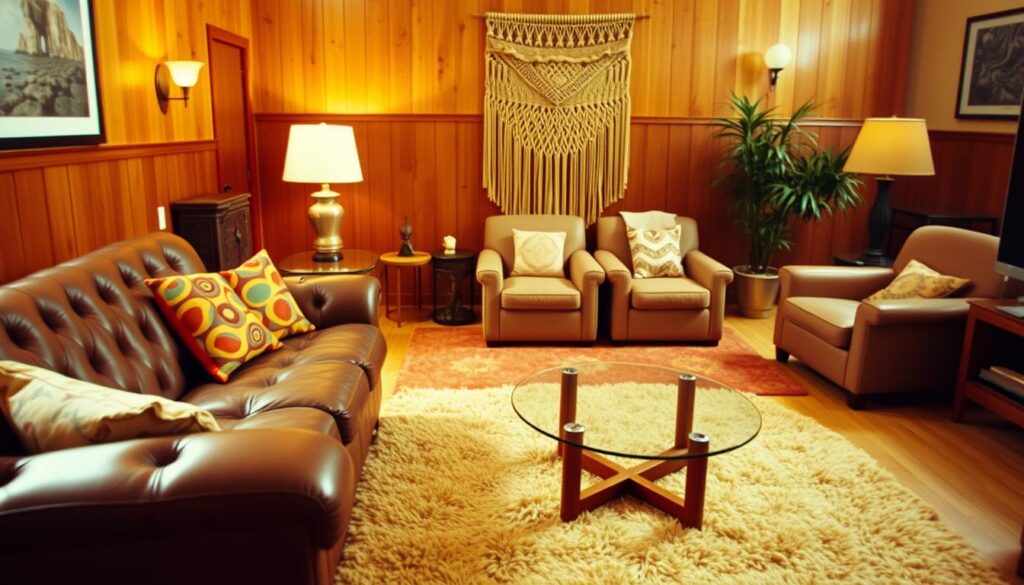
Iconic Furniture Pieces
The decade was famous for its iconic furniture. Bean bag chairs and conversation pits were big hits. They showed a new way of thinking about living spaces, making them more relaxed and casual.
These items were not just useful; they were also trendy. They showed the era’s love for fun and leisure.
Functional vs. Fashionable Designs
Designers of the 1970s combined beauty with practicality. Storage ottomans were a great example. They were both seats and places to store things, showing the era’s smart style.
This mix of looks and use was key to 1970s design. It met the needs of a generation that loved both beauty and usefulness.
Tips for Sourcing Vintage Items
If you want to add 1970s furniture to your home, there are good ways to do it. Start by checking out thrift stores and antique shops. They often have unique finds.
Online marketplaces also have a lot of vintage furniture. But, make sure to check the items well for realness and condition. When fixing up old furniture, keep its original feel but also make it safe and comfy.
By choosing 1970s furniture, you can bring a retro vibe to your home. It’s a way to mix old charm with today’s comfort. Whether you like the funky or vintage looks of the 1970s, there’s plenty of inspiration in its furniture.
Lighting Trends in 1970s Interiors
Lighting in the 1970s was more than just light. It was an art form that showed off the era’s style. The decade mixed function with flair, making lights into pieces of art.
Unique Light Fixtures
The 1970s brought us some unique light fixtures. Lava lamps were everywhere, with their colorful wax flows. Sputnik chandeliers added a space-age vibe to rooms.
Globe lights offered a soft glow, and macramé shades brought a handmade touch. These lights were more than just light sources. They sparked conversations and showed off the decade’s spirit.
The Importance of Ambient Lighting
Ambient lighting was key in 1970s homes. It aimed to create a cozy, inviting feel. Dimmers, layered lighting, and smart light placement were used to achieve this.
“The right lighting can transform a space, making it feel cozy and inviting. In the 1970s, this was true, as ambient lighting was central to decor.”
How to Incorporate Vintage Lighting
Adding vintage lighting to your home can bring character and honor 1970s design. Look for original pieces or reproductions that capture the era’s essence. Match the style and scale of your space, and mix vintage with modern for a unique vibe.
- Find vintage lighting at thrift stores, antique shops, and online.
- Think about restoring vintage lights to their former glory.
- Blend vintage lighting with modern decor for a balanced look.
By embracing 1970s lighting trends, you can add retro charm to your home. It’s a way to celebrate the era’s innovative design.
Wall Treatments and Decor
In the 1970s, home interiors got a bold makeover. The decade was all about daring and innovative wall decor. Wall treatments were key to this bold look.
Bold Wallpaper Choices
The 1970s brought back bold, statement wallpaper. These patterns were big and colorful, with florals, geometrics, and abstracts. Not just for accent walls, rooms were fully covered in these vibrant prints.
Iconic 1970s wallpaper mixed earthy tones with bright colors. This mix added depth and interest to rooms. It made wallpaper a central part of retro design.
Paneling Trends of the Era
Wood paneling was big in the 1970s. It added warmth and texture to rooms, in various styles. From dark woods to light finishes, it covered walls for a cozy feel.
Paneling also went on ceilings and wainscoting. This showed the decade’s love for textured walls. It made homes warm and inviting.
Artwork that Captured the Spirit
Art in the 1970s was diverse and vibrant. Posters, prints, and original art decorated walls. From psychedelic posters to abstract art, choices were eclectic and bold.
| Artwork Type | Characteristics | Impact on 70s Era Design |
|---|---|---|
| Posters | Colorful, often featuring popular culture icons or advertisements | Added a playful, contemporary touch to rooms |
| Prints | Varied, including abstract designs and photographic prints | Contributed to the decade’s eclectic, expressive aesthetic |
| Original Art | Unique pieces, often reflecting the era’s avant-garde spirit | Personalized spaces, showcasing individual tastes |
The 1970s artwork reflected the decade’s culture and shaped interior design. Bold, expressive pieces let homeowners personalize their spaces and make a statement.
The Role of Technology in 1970s Design
Technology greatly influenced 1970s design, ushering in a new wave of creativity and innovation. The decade saw big leaps in materials science, appliance tech, and design ideas. These advancements helped shape the era’s unique look.
New Materials and Technologies
The 1970s brought in new materials that changed interior design. Plastics, for example, became popular for their flexibility and lasting quality. Designers started using plastic in furniture, lights, and decor, adding a modern feel to homes and making design more affordable.
There was a big increase in laminated plastics for countertops and shelves. These materials showed the era’s focus on being modern and functional.
“The use of new materials and technologies in the 1970s was a defining characteristic of the decade’s design aesthetic, enabling the creation of innovative and forward-thinking spaces.”
Influences of the Space Age
The Space Age deeply influenced 1970s design, bringing a futuristic and hopeful vibe. Designers took cues from space, using spherical shapes, retro-futuristic patterns, and metallic finishes in their work.
Space Age influences also showed up in lighting, with globe lights and sputnik chandeliers becoming symbols of 1970s design.
Modern Appliances and Their Styles
Modern appliances in the 1970s were not just useful but also made a statement. New styles, like avocado green and harvest gold, added color to kitchens. These appliances had bold colors and futuristic looks.
| Appliance | Common Colors | Design Features |
|---|---|---|
| Refrigerators | Avocado Green, Harvest Gold | Bold color finishes, rounded edges |
| Stoves | White, Black, Avocado Green | Retro-style knobs, futuristic designs |
| Microwaves | White, Stainless Steel | Compact designs, digital displays |
These appliances did more than just work; they added to the funky vibe of 1970s homes. Their unique looks and colors were key to the era’s mid-century modern style.
1970s Kitchen and Bathroom Designs
The 1970s brought big changes to kitchen and bathroom design. New materials and iconic fixtures are still loved today. This era mixed function with style, letting homeowners show off their taste.
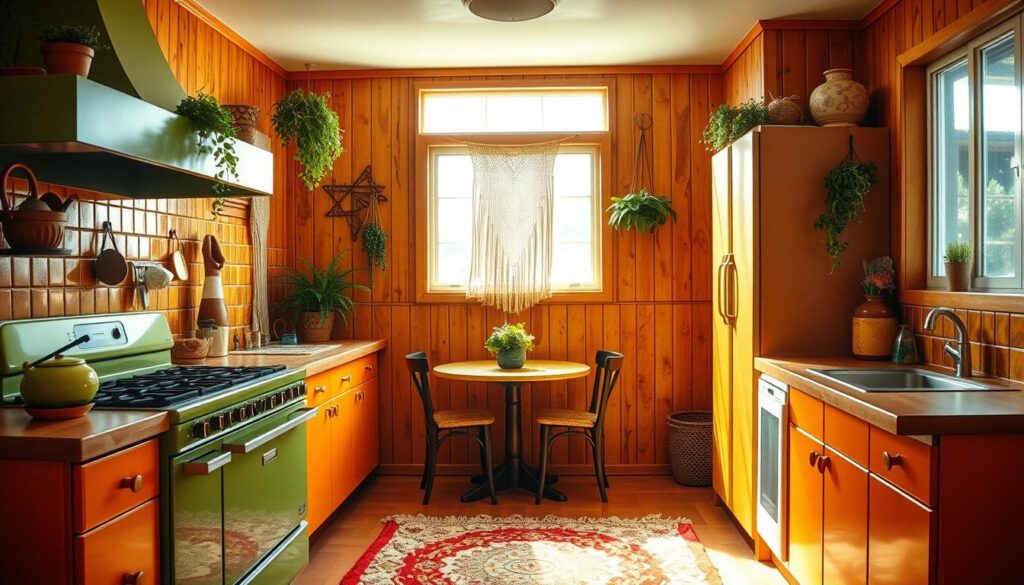
Key Features of Retro Kitchens
Retro kitchens of the 1970s were bold and colorful. Avocado green and harvest gold were top picks for appliances and fixtures. They also had funky patterns on walls and floors, making them unique.
Some key features of retro kitchens include:
- Bold color choices
- Iconic appliances like avocado green and harvest gold refrigerators and stoves
- Patterned flooring and wallpaper
- Use of natural materials like wood for cabinets and paneling
| Feature | Description | Popular Choices |
|---|---|---|
| Color Scheme | Bold and vibrant | Avocado green, harvest gold |
| Appliances | Iconic and colorful | Avocado green, harvest gold refrigerators and stoves |
| Flooring | Patterned and textured | Linoleum with geometric patterns |
Vintage Bathroom Essentials
1970s bathrooms were stylish and comfortable. Shag rugs and macramé plant holders added warmth and texture. Brass faucets and mirrored cabinets brought glamour.
“The 1970s bathroom was a sanctuary, a place where one could relax and unwind in style.” – Design Historian
Blending Functionality with Style
To add 1970s charm to your kitchen or bathroom today, mix old charm with new function. Here’s how:
- Choose vintage-inspired appliances and fixtures
- Use retro colors through accessories or accent walls
- Add textured elements like shag rugs or macramé
- Use natural materials for cabinets and countertops
By embracing 1970s design, you can make a space that’s both nostalgic and modern. It will be functional and stylish.
Incorporating 1970s Design Today
Want to add some retro charm to your home? Think about using 1970s design elements. The 1970s were a time of creativity and experimentation in design. This led to a unique, eclectic style that’s still appealing today.
Tips for a Retro Makeover
To give your home a retro look, start with earthy tones and vibrant accents. Use natural materials like wood and stone. Add vintage flair with retro-patterned fabrics and wallpaper.
For a subtle touch, use 1970s design elements in accessories. Think vintage posters, macrame wall hangings, or retro-style lighting. For a bolder look, add vintage furniture or retro-inspired appliances.
Balancing Vintage and Modern Elements
When mixing 1970s design with modern elements, balance is key. Pair retro furniture with modern decor. Or, use vintage accessories to add personality to a modern space.
For inspiration, check out our guide on crafting a mid-century modern home interior. It offers tips on blending vintage and modern styles.
Creating a Cohesive Space
To create a cohesive space, start with a unifying theme or color palette. This will tie together different elements and give your space a sense of continuity.
- Select a few key retro elements to feature prominently in your space.
- Use a mix of vintage and modern pieces to create a balanced look.
- Don’t be afraid to experiment and have fun with the design process!
By using 1970s design elements and balancing vintage and modern, you can create a unique, groovy space. This space will reflect your personality and style.
Conclusion: Celebrating 1970s Home Design
The 1970s was a decade all about self-expression and being unique. This spirit is still seen in today’s home interiors. The funky designs from back then still inspire many.
Cultural Significance of 1970s Design
The 1970s home design was bold and eclectic. It was shaped by the social and cultural shifts of the time. This led to spaces that were truly unique and expressive.
Enduring Appeal
1970s home design is still loved today. Its elements, like vintage decor, are making a comeback. They add a touch of retro charm to modern homes.
Embracing Retro-Inspired Spaces
When creating our own spaces, we can take cues from the 1970s. By using earthy tones and funky patterns, we can make a space that’s truly our own. It shows off our personality and style.

